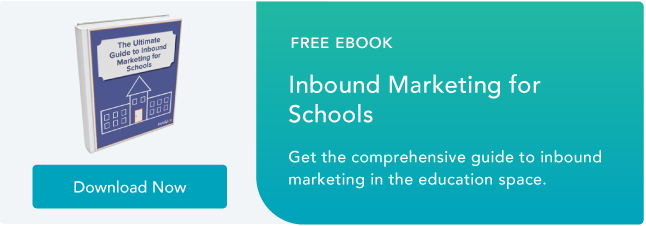
A great deal of inbound marketing for schools focuses on gaining the permission to market to someone via email. It's your job as a marketer to make sure you're offering content so on-target to your prospects' needs, that they're happy to share their information with you—and look forward to future communications.
Of course, getting a prospective student's email is just the first step. Once that the lead is in your contact database, are you continuing to share content that addresses their concerns and interests? Content that moves each lead further on the journey to application and then to enrollment?
While other means of content distribution, such as social media, blogs, and more, are vitally important—email still has special status. First, sharing their email is often the first step a prospect takes to identify themselves to you, and let you know they're interested. Second, people who share their email address and really do want you to send them additional content, need to you to earn their trust.
Collecting the Right Information to Send the Right Emails
Before I get to the three emails your potential students and parents want you to send them, I want to take a short, but critical detour. Let's talk about sign-up forms.
Effective email nurturing is all about sending the right emails to the right people. To do that, you need to know as much as you can about them to understand which persona they fit and where in their enrollment journey they are. Your sign-up forms are your collection plate for all this information.
At HubSpot, we recommend progressive profiling to make our forms easy for people to fill out, while gathering ever-more valuable intelligence about prospects at each and every conversion. We know that forms with fewer fields have higher conversion rates. So a form displayed to an unknown visitor on your website will only ask for a name and an email, perhaps also program area of interest. Using progressive profiling and Smart Forms, you can auto-populate future forms a prospect sees with the data you already have, and then ask for only one more piece of information.
For example, a 4 year college's form might ask a parent to provide their student's high school graduation date. Now that you know Parent Patty's kid is a sophomore, you won't email her reminders about application deadlines. Instead, you can send Patty an email about a Career Night event in her area featuring local alumni that she might want to attend with her son or daughter.
With every piece of information your forms collect, you can further segment your prospects into different lists to ensure they're getting email content geared just for them.
Choosing Compelling Email Topics
The three types of emails your prospects want to get roughly align with the phases in the enrollment cycle. Educational resources that educate prospects about your school and programs are perfect during the awareness phase. For the consideration stage, remind them of important dates throughout the application and enrollment cycle. Once a potential parent and/or student is in the decision stage, it’s time to make offers to connect directly and in-person.
These category-phase pairs aren’t bright lines. There are relevant emails to send prospects from each category in every phase. I’ll share some examples below.
1) Educational Resources
You already have a voluminous content collection you can share about your school or specific programs. You can draw material from existing course guides, course syllabi, and admissions collateral. Also take a look at descriptions of extra-curricular activities and student groups, and their activities. And, your blog content about program and alumni achievements are great sources.
Really, any content you already have about your school or its programs can be promoted by or shaped into an email. As always, the key is delivering the right school content to the right prospect. A private academy might send an excerpt with link to the blog post about the Ivy League college acceptance rate of its students to parent prospects. A student prospect who has shown interest in nursing will get a guide about the different types of nursing certifications and degrees offered. A student's parent who spent a lot of time on your financial assistance web page will receive an email about financial aid sources.
2) Important Dates
Reminder emails are always useful. Dates relevant to the application and enrollment cycle should be sent to the right prospect segments. Early phase emails can cover open houses, open alumni events, and career fairs. Later on, application deadlines, including early decision deadlines, and financial aid submissions will be helpful. After acceptance, an email encouraging confirming their enrollment spot before the deadline can boost enrollment rates.
You may also want to create a list of important dates or time frames, for certain tasks that don't necessarily have a firm deadline, but require a certain order and timeliness to be done right. Prospects identified while early in their research phase for a school could get emails about how soon to ask for written recommendations, or when to narrow their research to a short list of schools. You can also email information about when and where to research for scholarship opportunities.
Last, get copies of all program and student groups activities calendar, and scour them for other events and dates. Look for events that parents and students can attend that will give them a real taste of life at your school: parent-teacher nights, student performances, the Homecoming game, a faculty tea, open lectures sponsored by a program or student group.
3) Offers to Connect
Create a list of all the direct, person-to-person touch points you offer. Categorize them by journey phase. Start with the ways prospective students can interact with students, alumni or faculty, such as scheduled calls or meetings, or an invitation to a weekend program. You may want to promote signing up for a campus tour to early stage prospects to move them into the next phase of applying.
As they move further down the enrollment cycle, suggest a meeting with an admissions officer. Someone who's downloaded an application may be invited to meet with an admissions officer. Accepted applicants should get emails about meet-ups with other potential enrollees.
One Last Note for Your Emails
Whatever the topic of your email, make sure it includes a call-to-action (CTA) that tightens the relationship between your institution and the prospect.
In some cases, like offer-to-connect emails, the CTA is obvious. You want the prospect to register for that tour or arrange that interview. But all your emails should have one CTA relevant to the email's content. It may be the link back to the blog post or to download a new guide that provides more in-depth discussion of the email's topic. For educational resource emails, always encourage the recipient to forward or share the email with people they think would also find it interesting.
Having a follow-up CTA in the email not only pulls the prospect forward in the journey, but also provides more intelligence about that prospect to you, so your next email to the prospect is even more welcome.
from HubSpot Marketing Blog http://blog.hubspot.com/marketing/3-emails-your-school-should-send-to-improve-application-and-enrollment-rates
Via http://blog.hubspot.com/marketing/3-emails-your-school-should-send-to-improve-application-and-enrollment-rates

No comments:
Post a Comment